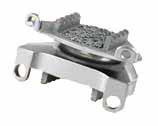Artificial Disc Replacement
 Degenerative disease of the spine is one of the leading causes of disability in the adult population. Most of these patients are treated non-surgically with analgesia, physiotherapy and injections. The majority will get better without surgery. However, a group of patients will continue to experience pain. The chronic nature of spinal pain can be disabling and interferes with the ability to work and participate in regular daily activities. For these patients, surgical treatment becomes necessary.
Degenerative disease of the spine is one of the leading causes of disability in the adult population. Most of these patients are treated non-surgically with analgesia, physiotherapy and injections. The majority will get better without surgery. However, a group of patients will continue to experience pain. The chronic nature of spinal pain can be disabling and interferes with the ability to work and participate in regular daily activities. For these patients, surgical treatment becomes necessary.
Surgical treatment for degenerative spine disease has traditionally been spinal fusion. Unfortunately, there are a number of drawbacks to spinal fusion. Firstly, the bone may not be able to heal or fuse. The average success rate of fusion is approximately 80%. Failure of the bone to fuse may be associated with continued symptoms. Secondly, fusion will cause stiffness and decreased motion of the spine. Thirdly, spinal fusion will cause more stress to be transferred to adjacent levels. This increased stress at the adjacent level may cause further degeneration at the adjacent levels which may lead to additional spine surgery.
Artificial disc replacement is a surgical procedure in which degenerated intervertebral discs in the spinal column are replaced with artificial devices in the lumbar (lower) or cervical (upper) spine. The procedure is used to treat chronic, severe low back pain and cervical pain resulting from degenerative disc disease.
|
Figure 1. Lumbar Artificial Disc |
Figure 2. Cervical Artificial Disc |
Artificial disc replacement has been developed as an alternative to spine fusion. The introduction of the total disc replacement aims to relieve patient symptoms while preserving motion at the operative spinal level. The advantage of preserving motion is to minimize the stress at adjacent levels and thereby decrease the risk of degeneration of the adjacent segment.
Currently artificial disc replacement can be used for the lumbar or the cervical spine. Many different models have been developed. The majority consists of two metal plates that have teeth to anchor the implant onto the bone of the vertebral bodies. Between the two plates is a metal core or a plastic core made up of polyethylene that allows for motion. Figure 1 shows a lumbar artificial disc replacement. Figure 2 shows a cervical artificial disc replacement.
The clinical diagnoses for lumbar artificial disc replacement include symptomatic degenerative disc disease and post-discectomy syndrome. Post-discectomy syndrome is persistent back pain following previous surgery to remove a herniated disc. For cervical artificial disc replacement, the diagnoses include cervical radiculopathy (where the nerve root is compressed) and cervical myelopathy (where the spinal cord is compressed).
The technique to insert an artificial disc (whether in the neck or low back) is routine and safe. For the cervical spine it involves going from the front of the neck. For the lumbar spine, it involves going through the abdomen. The procedure begins by removing the gelatinous disc between the vertebrae. Once the disc is removed, two metal plates are pressed into the bony endplates above and below the space now vacated by the disc. Metal spikes hold these plates in place on the bone. Eventually bone will grow over and around the metal plates. In between the metal plates is a metal or plastic core made of a polyethylene. Figure 3 shows the artificial disc placed in the spine.

Figure 3. Artificial Disc Placed in Spine
Careful selection of patients for artificial disc replacement is critical. There are several conditions that may prevent patients from receiving a disc replacement. These include spondylolisthesis (the slipping of one vertebral body across a lower one), osteoporosis, vertebral body fracture, allergy to the materials in the device, spinal tumor, spinal infection, morbid obesity, significant changes of the facet joints (joints in the back portion of the spine), pregnancy, chronic steroid use or autoimmune problems. Also, total disc replacements are designed to be implanted from an anterior approach (through the abdomen for lumbar). Patients may be excluded from receiving an artificial disc if they previously had abdominal surgery or if the condition of the blood vessels in front of the spine increases the risk of significant injury during this type of spinal surgery.
In addition to the potential complications associated with general anesthesia, the complications associated with artificial disc replacement may include breakage of the metal plate, dislocation of the implant, infection, nerve injury and injury to blood vessels and urological structures. To help minimize complications associated with the implant itself, proper selection of patients and size of implant is very important. Also, artificial implants may fail over time due to wear of the materials and loosening of the implants.
Recovery from artificial disc replacement and care afterwards are much like that for other anterior approaches to the spine. In some cases, recovery is faster than for a traditional fusion surgery. There is less pain from the procedure and fewer complications in general. Another potential advantage of disc replacement is a more rapid return to activities than occurs after fusion surgery. Fusion patients have limited activities during the time required for the bone graft to grow into a solid mass. Because one of the goals of artificial discs is motion, patients are encouraged to return to motion early, although at a gradual progression. The length and type of activity restrictions following surgery are also much less with disc replacement.
Expert Author:
Dr Benedict Peng, Island Orthopaedic Consultants
Further Reading
The article above is meant to provide general information and does not replace a doctor's consultation.
Please see your doctor for professional advice.


